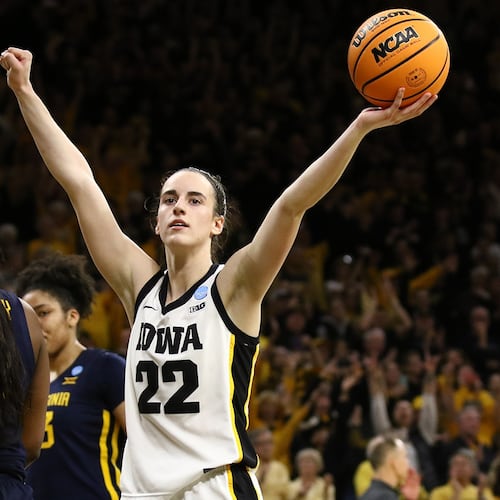It said something about the Braves’ rotation that Julio Teheran, who made the 2018 postseason roster as a long reliever, was again the starter on opening day. What it said was that Mike Foltynewicz, Mike Soroka and Kevin Gausman broke camp on the injured list. By process of elimination, Teheran took the ball in Game 1 for a sixth year running.
It says something else — two somethings, actually — that Teheran has become, after Soroka, the Braves’ second-most reliable starter. It says he’s having his best season since 2016. It also says the rest of the rotation is in a rut.
Max Fried, who caught a rolling start, has yielded nine earned runs in 9-2/3 innings over his past two turns. His Baseball-Reference WAR value is 1.2. Foltynewicz has an ERA of 6.10 and has been touched for two-plus homers in five of his eight starts. His WAR is minus-0.6. Gausman’s ERA is 5.56; he lasted one inning in his last start. (He’s scheduled to work in Pittsburgh tonight.) His WAR is minus-0.3.
Caveat: Every starting pitcher has wobbles. Reality check: Fried hasn’t been part of a big-league rotation before; Foltynewicz hasn’t looked right all season; Gausman has been in the bigs since 2013 and basically is just another guy. Meanwhile, the most likely candidates to step into the breach — Sean Newcomb and Touki Toussaint — have become key figures in a bullpen that has, goodness knows, its issues.
As for the farm system: Kolby Allard’s ERA at Triple-A Gwinnett is 4.58; Kyle Wright’s is 7.41. (Bryse Wilson’s is 3.92, however.) Luiz Gohara hasn’t pitched this year. Ian Anderson, Kyle Muller and Joey Wentz are in Double-A. There’s pitching aplenty in this chain, but the struggles of Allard, Wright and Gohara have complicated matters. Which brings us to …
Dallas Keuchel.
Not going to lie: I laughed at the notion that the unsigned free agent might wind up here, for the simple reason that he’s a starting pitcher who’ll cost a lot of money and the Braves figured to be loaded with starting pitching. More reality: Those Braves’ starters have compiled an ERA of 4.25, way up from the 3.50 of last season, and that’s with Soroka making like Don Drysdale. That’s a bit scary, too.
Soroka is 21. He worked 56-1/3 innings last season before being shuttered with shoulder issues after June 19. Counting rehab starts with Gwinnett, he’s at 66-1/3 innings in 2019. His maximum career workload was 153-2/3 minor-league innings in 2017. He’s on pace to work 179 innings this season, not counting postseason, and if there’s one pitcher the Braves want to keep healthy for the next 10 years, it’s Soroka. An innings cap could be on the horizon.
Back to Keuchel: Joel Sherman of the New York Post reports the 31-year-old would want $11.5 million just to finish this season, which is nearly 40 percent done, and there's no way he'll sign a contract that doesn't stretch two years beyond this one. Another report listed the Yankees and Braves as leading contenders for Keuchel, and it's now possible to see why the Braves would have interest. A month ago, the bullpen seemed the area of crying need. A month ago, this rotation looked a darn sight better than today.
That’s not Teheran’s fault. The Braves have won five of his past six starts, over which yielded three earned runs and zero homers. On April 25, his ERA was 5.40; today it’s 3.28. He ranks 10th among qualifying National League pitchers in ERA. He’s fourth in opponents’ batting average, fifth in opponents’ slugging percentage. His WAR is 1.6, notable because his full-season WAR for 2017 and 2018 was 1.6 and 1.8.
Off those numbers, Teheran is having a very nice season. Other numbers make you wonder how. Of his 13 starts, only four have met the “quality” standard, meaning six-plus innings with fewer than three earned runs. It’s not the runs that are denying him; it’s the innings. Teheran is averaging 5-1/3 innings per start. He’s also averaging 94.2 pitches. In the argot of baseball, he’s a nibbler.
Here’s general manager Alex Anthopoulos’ description of Teheran: “He doesn’t give in.” He throws five different pitches — four-seamer, sinker, curve, slider and change — and some hitters see all five in one at-bat. The younger Teheran, the All-Star of 2014 and 2016, walked two batters per nine innings. The 28-year-old Teheran of 2019 walks 4.5 batters per nine.
Teheran arrived in the majors in 2010 with a four-seamer averaging 96.51 mph; his 2019 fastball averages 90.25. He never was strictly a power pitcher, and by 2013 he'd become a craftsman. For the middle part of the decade, he was one of the 10 best pitchers in the National League. Then he wasn't. He'd still strike people out, but his walks soared. For better or worse, this has become Julio's Way. He'd rather walk someone than cede a hit.
In 2016, his strike percentage was 65.4 percent; today it’s 60.8. In 2014, he averaged 3.70 pitches per batter; today it’s 4.03. In 2014, opponents averaged 8.1 hits per nine innings; today it’s 7.8. He has made his peace with bases on balls, treating them as the cost of doing business with a 90-mph fastball. If you’re a neutral, his refusal to throw a fat pitch can be fun to watch. If you’re a Braves fan — or the Braves manager/pitching coach — his walks can make you crazy.
Those walks — and the resulting higher pitch counts — are why Teheran has seen the seventh inning only once this season. He has become a five-inning starter, which sounds worse than it is. If those five innings are good innings, many teams would be happy to live with that. The Braves might be less happy. Short starts tax the bullpen, and this bullpen isn’t brimming with quality.
There was a time when the Braves deemed Teheran their closest thing to a No. 1 starter, but that was a while back. At present, he’d make a solid No. 4. Trouble is, he has become the default No. 2. If the Braves are to see October, they’ll need more and better. Maybe it’s a settled Foltynewicz. Maybe it’s a re-purposed Newcomb or Toussaint. Maybe it’s Dallas Keuchel or Madison Bumgarner.
About the Author
The Latest
Featured

